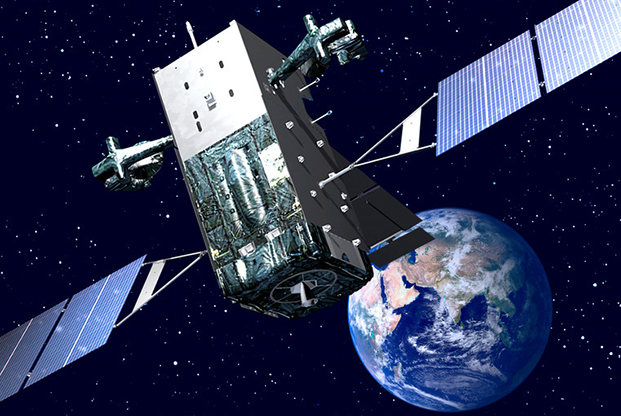
The Space Development Agency will pursue a 20-satellite constellation in low-earth orbit for resilient communications, missile defense and more, similar to the Air Force Space Based Infrared System satellite illustrated here by Lockheed Martin. Lockheed Martin graphic via Air Force Space Command.
The Space Development Agency plans to spend $525 million through fiscal 2024 on several studies and prototyping projects aimed at building a new constellation of small satellites in low-earth orbit, according to the Defense Department’s 2020 budget request.
SDA, established by acting Defense Secretary Patrick Shanahan in a March 12 memo, asks for $85 million for research and development in 2020 and ramps up to $140 million in 2024. The fledgling agency received a total of about $150 million in the Defense Department’s 2020 budget, which began rolling out March 12.
Last week, Pentagon research chief Mike Griffin told reporters the SDA’s first priority will be to develop a “highly proliferated low-earth orbit sensor and communications transport layer” to defend against hypersonic weapons, ensure communications systems can connect in an emergency, and boost global situational awareness.
New budget documents released this week show the LEO layer project will demonstrate a constellation of 20 small satellites that “heavily” draws on DARPA’s Blackjack program, which will start building parts in 2020. Officials view this transport layer as the “connective tissue” for a future space architecture.
“The SDA will develop an initial wedge of sub-constellations on this transport layer to provide additional capabilities, such as advanced missile warning … and, wherever feasible, leverage commercial industry plans to provide broadband Internet access from space,” according to the budget documents.
Researchers will work toward preliminary design reviews for the transport layer’s user terminals and missile-warning ground infrastructure in 2020, and will launch multiple studies on space traffic management, launch providers for small- to medium-size space situational awareness payloads, and alternatives to the current missile-warning ground systems.
Together, Griffin’s office and the SDA, Missile Defense Agency, Joint Staff, Air Force, and Cost Assessment and Program Evaluation Office also plan to assess space-based interceptors and a discrimination layer for missile defense.
“The space-based interceptor assessment entails developing a government reference architecture for a space-based kinetic interceptor layer for boost-phase defense,” budget documents state. “These efforts include developing an independent cost estimate and assessment of technical risks, potential countermeasures, and development timelines.”
Tom Karako, who directs the Missile Defense Project at the Center for Strategic and International Studies, told Air Force Magazine Tuesday the interceptor layer could be used for ballistic missile defense or to track some types of hypersonic missiles, if their launch follows a high ballistic arc.
For the project to gain traction, Karako said, SDA needs to be more innovative than past attempts by pursuing nanosatellites and lowering production and launch costs.
Griffin downplayed the idea that the SDA may be duplicating the efforts of DARPA’s Blackjack initiative, which is heading toward a critical design review for its satellite bus, sensor payloads, and autonomous controls in 2020 before manufacturing starts.
“Blackjack is a critical early experiment in this arena,” Griffin said. “In the Space Development Agency, we’re going to be trying to develop an objective system with very important peacetime uses. … It has to work. DARPA does experiments, not all of which have to work.”
Blackjack, another demonstration looking to spread small satellites across the cosmos in low-earth orbit, plans to piggyback on industry’s plans to offer global commercial broadband internet service from space.
“Capabilities demonstrated will provide constant custody of very large numbers of concurrent targets; target identification, tracking, and characterization; architectural resilience via massive proliferation; and rapid on-orbit technology refresh and experimentation,” DARPA’s 2020 budget shows.
Without offering details, the budget also mentions SDA will pursue “development of a deterrent capability.”
Griffin last week wouldn’t get into how SDA might work on the nuclear command, control, and communications enterprise, which will be overhauled as new nuclear weapons come online in the next few decades. But the budget notes one of SDA’s initial focuses is “cross-domain, networked, node-independent” battle management C3, including NC3 capabilities.
SDA intends to pursue “mission-agnostic” battle management and C3 capabilities and help transition current command-and-control systems to a new, consolidated BMC3 infrastructure.
On Monday, New Mexico’s congressional delegation wrote to Shanahan and other DOD officials urging them to put SDA headquarters in the state. New Mexico is also home to the Air Force Space and Missile Systems Center’s advanced systems and development directorate, the Air Force Research Laboratory’s space vehicles directorate, the space test program, the Space Rapid Capabilities Office, and other military and industry resources.
“The [Space RCO], in particular, provides the department with a tremendous opportunity to utilize the office’s unique acquisition authorities to develop and transition space systems quickly towards a more disaggregated space architecture,” stated the letter, signed by Democratic Sens. Tom Udall and Martin Heinrich as well as Reps. Ben Ray Lujan, Deb Haaland, and Xochitl Torres Small.
“We urge you to retain and strengthen each of our nation’s existing core R&D assets and, most importantly, to ensure that the DOD is not reinventing the wheel nor unnecessarily moving pieces around at the expense of limited taxpayer dollars,” the lawmakers wrote.